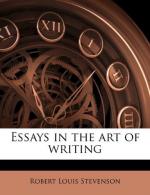Up to this moment I have had my eye mainly upon prose; for though in verse also the implication of the logical texture is a crowning beauty, yet in verse it may be dispensed with. You would think that here was a death-blow to all I have been saying; and far from that, it is but a new illustration of the principle involved. For if the versifier is not bound to weave a pattern of his own, it is because another pattern has been formally imposed upon him by the laws of verse. For that is the essence of a prosody. Verse may be rhythmical; it may be merely alliterative; it may, like the French, depend wholly on the (quasi) regular recurrence of the rhyme; or, like the Hebrew, it may consist in the strangely fanciful device of repeating the same idea. It does not matter on what principle the law is based, so it be a law. It may be pure convention; it may have no inherent beauty; all that we have a right to ask of any prosody is, that it shall lay down a pattern for the writer, and that what it lays down shall be neither too easy nor too hard. Hence it comes that it is much easier for men of equal facility to write fairly pleasing verse than reasonably interesting prose; for in prose the pattern itself has to be invented, and the difficulties first created before they can be solved. Hence, again, there follows the peculiar greatness of the true versifier: such as Shakespeare, Milton, and Victor Hugo, whom I place beside them as versifier merely, not as poet. These not only knit and knot the logical texture of the style with all the dexterity and strength of prose; they not only fill up the pattern of the verse with infinite variety and sober wit; but they give us, besides, a rare and special pleasure, by the art, comparable to that of counterpoint, with which they follow at the same time, and now contrast, and now combine, the double pattern of the texture and the verse. Here the sounding line concludes; a little further on, the well-knit sentence; and yet a little further, and both will reach their solution on the same ringing syllable. The best that can be offered by the best writer of prose is to show us the development of the idea and the stylistic pattern proceed hand in hand, sometimes by an obvious and triumphant effort, sometimes with a great air of ease and nature. The writer of verse, by virtue of conquering another difficulty, delights us with a new series of triumphs. He follows three purposes where his rival followed only two; and the change is of precisely the same nature as that from melody to harmony. Or if you prefer to return to the juggler, behold him now, to the vastly increased enthusiasm of the spectators, juggling with three oranges instead of two. Thus it is: added difficulty, added beauty; and the pattern, with every fresh element, becoming more interesting in itself.




